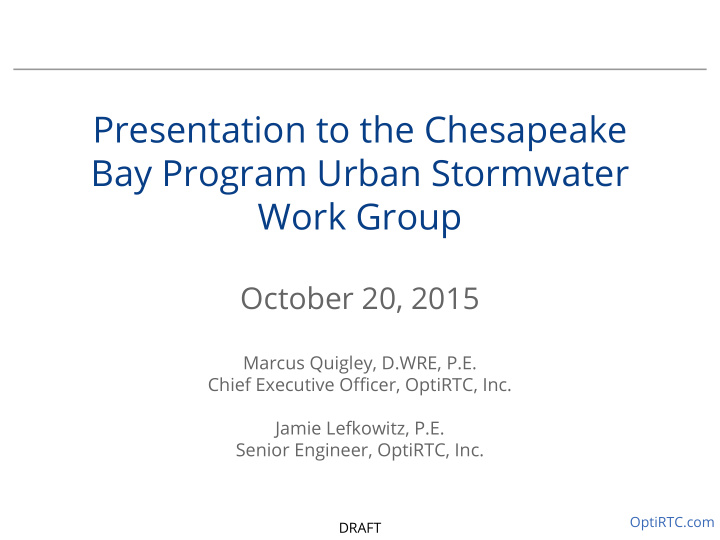



Presentation to the Chesapeake Bay Program Urban Stormwater Work Group October 20, 2015 Marcus Quigley, D.WRE, P.E. Chief Executive Officer, OptiRTC, Inc. Jamie Lefkowitz, P.E. Senior Engineer, OptiRTC, Inc. OptiRTC.com DRAFT
Continuously Monitored and Adaptive control (CMAC) Retrofits for Approved BMP Types Not a new technology - relies on existing approved BMPs for treatment, but has significant additional benefits: Benefits of Continuous Monitoring ● Direct verification of performance. ● Auditable performance and supporting data without additional cost. ● Increasing uptime of facilities through notification of operational issues. ● Reduce maintenance costs without sacrificing performance. Benefits of Adaptive Control ● Dramatically improving water quality from facilities by increasing residence time and/or improving unit process effectiveness (e.g., settling, denitrification). ● Reduce the frequency of flooding events. ● Enabling robust adaptable construction designs that are less dependant on site specific conditions. ● Allowing for updated operation to adapt systems to for future climatic conditions or changes in site characteristics. ● Utilizing an entire facilities storage volumes for the full range of storm event sizes. ● Intelligently detain flows in combined sewer systems for release during non-critical periods. ● Restoring pre-development hydrology (i.e., flow-duration matching) by actively modulating release rates based on forecast information. ● Increasing the volume retained on site. ● Maintaining ecological base flows. ● Allowing for changes to operation without major redesign or reconstruction. OptiRTC.com DRAFT
Continuous and adaptable stormwater management Combine sensor data, weather forecasts, and algorithms to optimize stormwater infrastructure through active, cloud-based control 1. level sensor 2. actuated valve 3. internet/cellular connection 4. grid or solar power 5. stormwater infrastructure -Cloud architecture -Robust data security -Advanced user authorization -Configurable logic algorithms that optimize complex, multi-variable results -Online dashboard interfaces -APIs for data export/analytics OptiRTC.com
BMP Conversion : Dry to Wet Pond Modeling ● 50 years of hourly rainfall data from BWI ● Simulated passive dry pond and active retrofit to wet pond ● Various storage sizes ● 74 percent wet weather capture by volume ● 70 percent asset volume utilization during wet weather ● 270-hour average retention time of discharged water ● Complete runoff retention 76 percent of wet weather hours OptiRTC.com DRAFT
BMP Enhancement : Wet Pond Retrofit 120 acre drainage area Runoff from 0.2” in storm event or 0.12” of impervious storage Very small existing pond OptiRTC.com DRAFT
Results of Extensive Field Monitoring Accurate and Precise Performance Metrics Water Quality Stream Restoration 0.1 watershed inches of storage - dramatic increases in retention time for a very small facility Quantitative and Verifiable Reporting Data OptiRTC.com DRAFT
Increased control ➝ Increased retention time ➝ Increased WQ benefit increased removal of smallest particle fraction with increased active control Muchalla et al. 2014 Dry pond to wet pond retrofit (no active 48-60% better removal efficiency of small control) increased retention time and particles in pond with active, rainfall-driven improved TSS and ammonia-nitrogen removal control efficiencies Muchalla et al. 2014 TSS: from 39 to 90% Smaller particles have higher associated NH 3 -N: from 10 to 84% phosphorus concentrations than larger Carpenter et al. 2014 particles Gaborit et al. 2012 Moquecho and Pitt 2005 OptiRTC.com DRAFT
Credit Calculation: possibilities with quantification of volume treated actual removal for runoff detained (volume reported) credit for undersized wet pond example OptiRTC.com DRAFT
CMAC Facility Types Conversion Types Dry Pond to Wet Pond ● Wet Pond to Wet Extended Detention Pond ● Enhancements Wet Extended Detention Ponds ● Bioretention ● Wetlands ● Demand Dependant Cisterns to Fully Utilized Cistern ● Infiltration Facility ● Benefits Increased residence time ● Increased volume retained ● Restore pre-development hydrology ● And additional benefits ● OptiRTC.com DRAFT
References Carpenter, Jason Faber, Bertrand Vallet, Genevieve Pelletier, Paul Lessard, and Peter A. Vanrolleghem. Pollutant removal efficiency of a retrofitted stormwater detention pond. Water QUality Research Journal of Canada. 49.2. 2014. Gaborit, Etienne, D. Muschalla, B. Vallet, P.A. Vanrolleghem, and F. Anctil. Improving the performance of stormwater detention basins by real-time control using rainfall forecasts. Urban Water Journal, Vol. 10 No. 4, 230- 246. 2013 Morquecho, R., R. Pitt, S. Clark. Pollutant Associations with Particulates in Stormwater. World Water & Environmental Resources Congress, ASCE/EWRI. Anchorage, Alaska. May 15 – 19, 2005. January 2005. Muschalla, Dirk, Bertrand Vallet, Francois Anctil, Paul Lessard, Genevieve Pelletier, Peter A. Vanrolleghem. Ecohydraulis-driven real-time control of stormwater basins. Journal of Hydrology. 511, 82-91. 2014. OptiRTC, Inc. Report on Nationwide Continuous Simulation Modeling of Forecast-Based Control BMP Performance Using the EPA Stormwater Management Model (SWMM). 2015. Schueler, Tom and Cecilia Lane, et al. Recommendations of the Expert Panel to Define Removal Rates for Urban Stormwater Retrofit Projects. Chesapeake Bay Program. 2012. Water Environment Research Foundation (WERF). Transforming our Cities: High-Performance Green Infrastructure. WERF and IWA Publishing. 2014. OptiRTC.com DRAFT
Recommend
More recommend